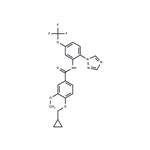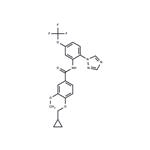As many mGlu allosteric ligands engage induced-fit pockets, SAR can be challenging, and the “right” fit may only be “found” by exploring libraries of analogs via an exercise in strategic serendipity. VU6012962 (7d) proved optimal (IC50 = 350 nM, pIC50 = 6.46 ± 0.10, 12.6 ± 1.5% L-AP4 min) and the most potent within this chemotype to date. Beyond an enhancement in mGlu7 NAM potency, 7d also showed a significant improvement in predicted hepatic clearance (rat CLhep = 15.9 mL min–1 kg–1), generating enthusiasm for the further profiling of 7d. 7d was selective for mGlu7 versus the other seven mGlu receptors (>10 μM versus mGlu1–6,8) and largely devoid of ancillary pharmacology (compound activity at only one target, 5-HT2B receptor, that was greater than 50% at 10 μM) in a Eurofins lead profiling panel of 68 GPCRs, ion channels, and transporters. A 30 mg/kg (ip) tissue distribution study in rat was performed to assess levels of 7d in plasma, brain, and CSF. Here, it was noted that a brain:plasma Kp of 1.24 (([plasma]tot = 598 nM), [brain]tot = 745 nM) and a Kp,uu of 0.38 ([plasma]Unbound = 16.7 nM, [brain]unbound = 6.4 nM); however, the CSF:plasma Kp was 2.15, with levels of 7d in CSF of 1.3 μM, or ~3.8-fold above the in vitro IC50._x000D_
_x000D_
Reference: J Med Chem. 2019 Feb 14;62(3):1690-1695. https://www.ncbi.nlm.nih.gov/pmc/articles/pmid/30608678/
![Benzamide, 4-(cyclopropylmethoxy)-3-methoxy-N-[2-(1H-1,2,4-triazol-1-yl)-5-(trifluoromethoxy)phenyl]- Structure](/CAS/20200611/GIF/2313526-86-0.gif)

